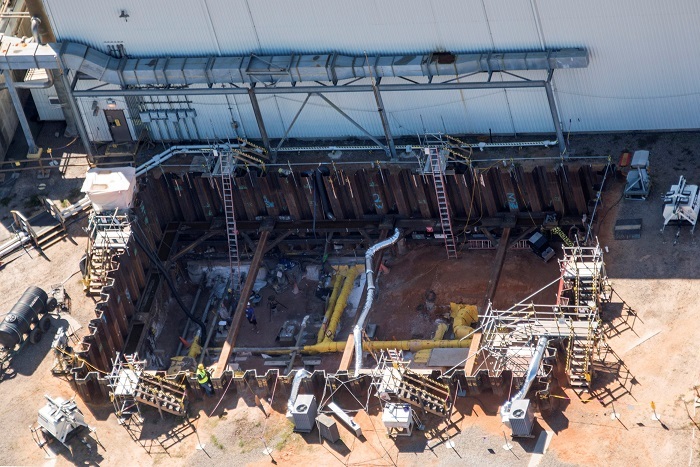
Workers excavated an area at the Savannah River Site to reveal existing transfer lines to be modified for placing the new Salt Waste Processing Facility into operations.
AIKEN, S.C. – EM has successfully integrated the liquid waste treatment system with the Salt Waste Processing Facility (SWPF) at the Savannah River Site (SRS) after 10 years of complex preparatory work.
EM and liquid waste contractor Savannah River Remediation (SRR) made many improvements to prepare SRS liquid waste facilities to handle the output from SWPF and ensure that facility could be fed large quantities of salt waste from the site’s 43 remaining high-level waste tanks.
SRR President and Project Manager Phil Breidenbach said SRR’s dedication to the liquid waste cleanup mission is helping make EM history.
“The work that led to full integration with the Salt Waste Processing Facility is truly historic,” Breidenbach said. “We demonstrated technology, modified infrastructure that is over 65 years old, and modified procedures and programs to ready the liquid waste facilities. The talented team of SRR professionals all share the same goal — to eliminate the greatest risk in the state of South Carolina. Together as a team, we are making the community and environment safer.”
Workers performed research, planning, documentation, and other work to ready 1-million-gallon salt batches for transfer to SWPF. They added transfer lines, excavated a large area to reveal piping for modifications, installed large pumps, and revised documents governing operational procedures.
SWPF integration work was completed without injuries resulting in missed workdays. Safety was the top priority throughout the integration process, as crews trained with mock-ups, deployed remote equipment, and implemented other controls to reduce the risk of radiological and industrial hazards.
SWPF is key to accelerating the disposition of salt waste, which makes up approximately 90 percent of the site’s tank waste volume. Workers previously processed salt waste at the site’s interim salt waste processing facilities, known as the Actinide Removal Process/Modular Caustic Side Solvent Extraction Unit. That operation successfully demonstrated the technology being used in the larger-scale SWPF.
The first transfer of 4,000 gallons of salt waste through roughly 4,000 linear feet of stainless-steel piping from the site’s Tank 49 to SWPF is pending. The salt waste will be processed inside SWPF into two streams: a high-activity radionuclide stream for transfer to the Defense Waste Processing Facility, and a decontaminated salt solution to be sent to the Saltstone Production Facility.
Salt batches are prepared in blend tanks to meet waste acceptance criteria at SWPF, due to each waste tank containing a unique blend of radioactive liquid waste and chemicals. Workers recently modified Tank 41 to become a salt waste blend tank in support of SWPF operations. This work was accomplished by dissolving salt cake in the tank for transfer and installing a submersible blend pump. An additional blend tank, Tank 42, is scheduled to be operational in May 2021.
After crews completed modifications to connect the liquid waste facilities to SWPF, employees with SRR and SWPF contractor Parsons practiced future operations through simulated salt waste transfers between the liquid waste facilities and SWPF. The exercises were an opportunity for the team members to follow new and revised procedures.
-Contributor: Ashley Dernberger
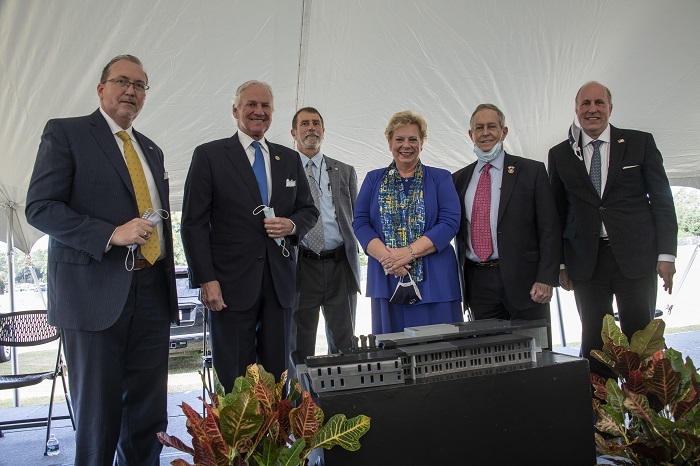 From left, Aiken Mayor Rick Osbon, South Carolina Gov. Henry McMaster, DOE Savannah River Laboratory Office Director Tony Polk, University of South Carolina-Aiken Chancellor Dr. Sandra J. Jordan, Rep. Joe Wilson of South Carolina, and Under Secretary for Science Paul Dabbar stand behind a 3-D model of the proposed Advanced Manufacturing Collaborative facility to be built at the University of South Carolina-Aiken.
AIKEN, S.C. – DOE and the University of South Carolina-Aiken (USCA) unveiled a 3-D model of the proposed Advanced Manufacturing Collaborative (AMC) facility last week to be built on the USCA campus, providing accessible, modern, and flexible laboratory space for EM’s Savannah River National Laboratory and its collaboration partners.
Among the participants in the unveiling were Under Secretary for Science Paul Dabbar, who referred to the project as a “trifecta,” leveraging federal agencies, private enterprise, and academia. Other attendees included Rep. Joe Wilson of South Carolina; South Carolina Gov. Henry McMaster; USCA Chancellor Dr. Sandra J. Jordan; Aiken Mayor Rick Osbon; and DOE Savannah River Laboratory Office Director Tony Polk.
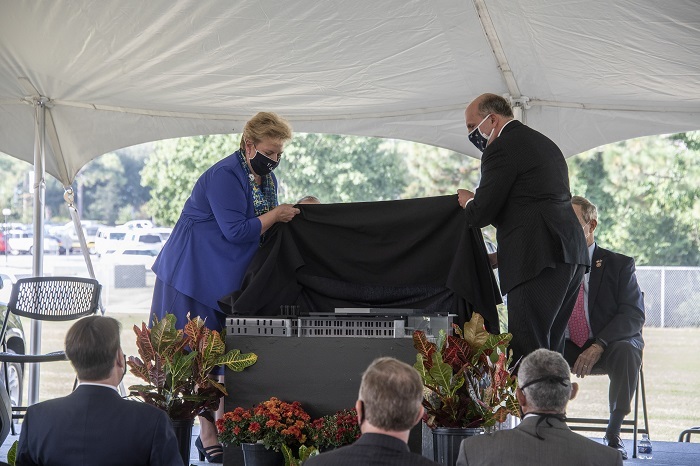 University of South Carolina-Aiken Chancellor Dr. Sandra J. Jordan and Under Secretary for Science Paul Dabbar unveil a 3-D model of the proposed Advanced Manufacturing Collaborative facility to be built at the University of South Carolina-Aiken.
Jordan commended the Department for supporting a facility that will inspire and explore innovation.
“The Department of Energy's investment in the future of the Savannah River National Laboratory and simultaneously in this region, and the Department's commitment to providing a high-quality work environment where scientists, engineers, and technologists explore the outer boundaries of innovation continues to inspire me,” Jordan said.
McMaster said, “This project will be an economic driver for the region and the state. The AMC will maximize industry and education and create more jobs for the state of South Carolina.”
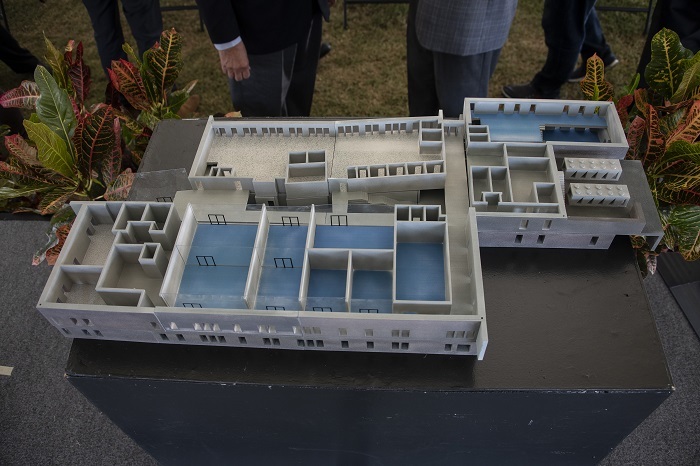 A 3-D model of the proposed Advanced Manufacturing Collaborative facility to be built at the University of South Carolina-Aiken.
Wilson noted that after working on the project for over five years, he was grateful to see it come to fruition and looked forward to the jobs and innovation the facility will create.
“I appreciate Chancellor Sandra Jordan’s dedication to creating a positive future for the next generation, and I am excited to see so many advocates of this project,” Wilson said.
“We can all agree that President Harry S. Truman’s decision to create the Savannah River Site in 1950 was an auspicious one for our city,” Osbon added. “We heeded the call to devote ourselves to the defense of our nation with the newest and most critical technology of the era. Seventy years later, the Savannah River Site is still committed to meeting the needs of our country.”
The facility would include chemistry and engineering fabrication laboratories, industrial space, staff offices, and other components.
-Contributor: DOE-Savannah River
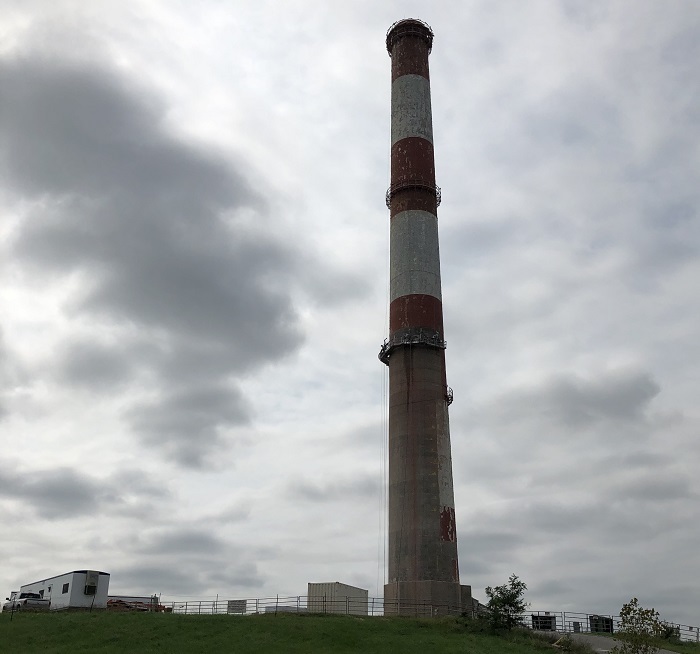
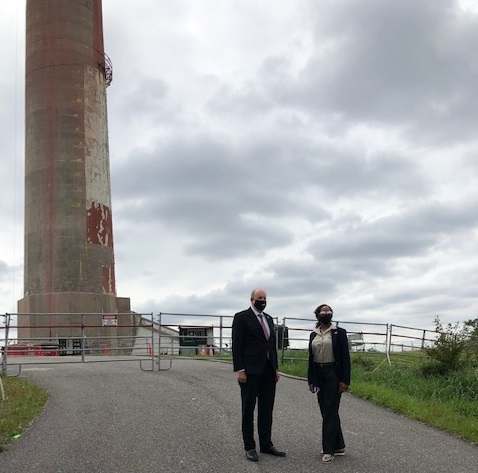
UPTON, N.Y. – Under Secretary for Science Paul Dabbar and Environmental Management Consolidated Business Center Deputy Director Melody Bell, pictured at left, recently visited Brookhaven National Laboratory and viewed progress in an EM project to demolish the High Flux Beam Reactor (HFBR) exhaust stack, pictured above. Anticipated for demolition by the end of this year, the distinctive 320-foot-tall, red-and-white stack was used for a small research reactor that DOE shut down more than 20 years ago. The HFBR provided a source of neutrons for multidisciplinary scientific research in materials science, chemistry, biology, and physics.
-Contributor: Stephanie Shewmon
|
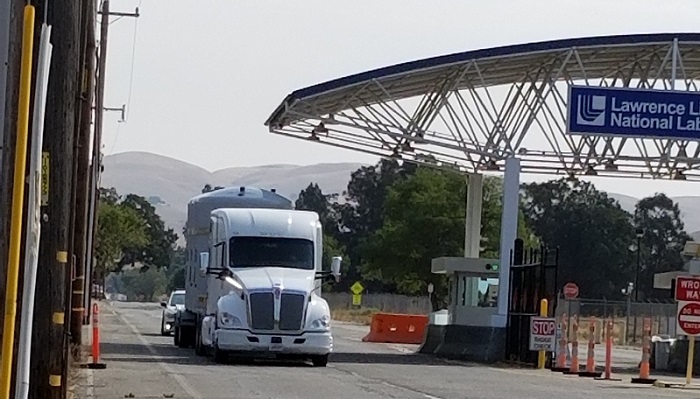 The first transuranic waste shipment from Lawrence Livermore National Laboratory in a decade departs the laboratory earlier this month.
The milestone shipment resulted from several years of coordinated effort with EM’s Carlsbad Field Office (CBFO); WIPP management and operations contractor Nuclear Waste Partnership; the National Nuclear Security Administration’s (NNSA) Office of Enterprise Stewardship; and NNSA’s Livermore Field Office.
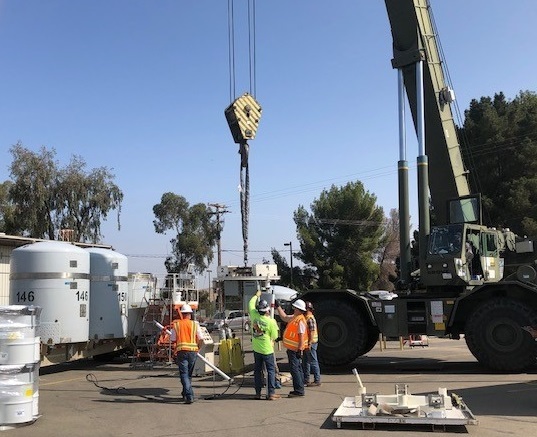 |
|
The Waste Isolation Pilot Plant mobile loading team processes a recent transuranic waste shipment from Lawrence Livermore National Laboratory. |
As a national security laboratory, LLNL generates TRU waste resulting from research in support of the national defense mission. Since the last TRU waste shipment campaign in 2010, LLNL has been accumulating newly generated waste in its storage facilities, which were projected to reach capacity this year. Without the ability to ship the TRU waste offsite, some research operations could be impacted.
In 2018, LLNL secured funding with NNSA’s Office of Safety, Infrastructure, and Operations to deploy the WIPP Central Characterization Program to characterize and certify LLNL’s inventory of TRU waste. This ensures that all the waste being shipped to WIPP meets disposal requirements for the facility. LLNL updated its safety basis documentation, underwent multiple readiness activities, and began characterizing its TRU waste in 2019.
Once the waste was certified and ready for shipment, the WIPP mobile loading team deployed to LLNL to load the waste containers into TRUPACT-II shipping packages. All WIPP shipments are tracked while en route to the facility using a satellite tracking system known as TRANSCOM, which helps ensure the safety of the shipments. The first shipment of the campaign safely arrived at WIPP on Sept. 19, following the approximate 2,000-mile journey.
The current campaign will continue until the newly certified TRU waste is safely removed from LLNL.
-Contributors: Robert Kong, Bobby St. John
RICHLAND, Wash. – When the Hanford Site moved to an essential mission-critical operations posture in late March to ensure the safety of the site and local communities, the number of employees that reported to work dropped to about 10 to 15 percent of the normal 11,000-person workforce. The site had been preparing for a significant reduction in activities and services for several weeks, and thousands of federal and contractor employees had already shifted to a telework status.
Approximately six months later, the site is in the second phase of remobilizing the onsite workforce. More people are working safely onsite than are teleworking, and employees continue to deliver safe progress while protecting the workforce and the local communities during the COVID-19 pandemic.
Shortly after the site began remobilizing in late May, Hanford’s liquid waste processing facilities marked 25 years of safely treating contaminated wastewater while stretching the storage capacity of the site’s underground double-shell tanks. Since 1995, the facilities have processed more than 330 million gallons of contaminated wastewater to remove radioactive and chemical waste, primarily from an industrial evaporator that boils liquid tank waste to evaporate water and increase storage space in the tanks system.
As work ramped up on the site, Hanford’s occupational medical services provider continued to adjust its services to help ensure the health and well-being of Hanford workers. Virtual options were set up for health education, work conditioning, the employee assistance program, and check-ins prior to returning to work. The medical services provider received a 100-percent patient satisfaction response in May, while maintaining an overall patient satisfaction level near that percentage this calendar year.
 Audrey Wright, health educator for the Hanford medical services provider, conducts a brief health screening for a worker entering one of the site’s occupational medical facilities.
In June, Hanford officials reported that groundwater treatment systems were on track to meet EM’s goal of treating at least 2.2 billion gallons of contaminated groundwater this fiscal year. Hanford’s advanced pump-and-treat systems allow operations managers to safely monitor the facilities remotely from home, meeting social distancing requirements while ensuring the facilities continued to operate efficiently. Hanford announced earlier this month that the annual treatment goal was surpassed for the sixth year in a row.
That same month, workers finished startup testing at the Analytical Laboratory in Hanford’s Waste Treatment and Immobilization Plant (WTP), marking the first nuclear facility at the plant to reach that point prior to moving into the commissioning phase for operations. That laboratory is a critical part of the system that will be used to treat millions of gallons of waste from Hanford’s underground storage tanks through the Direct-Feed Low-Activity Waste approach. Moving these facilities from the construction to commissioning phase is one of EM’s priorities for 2020.
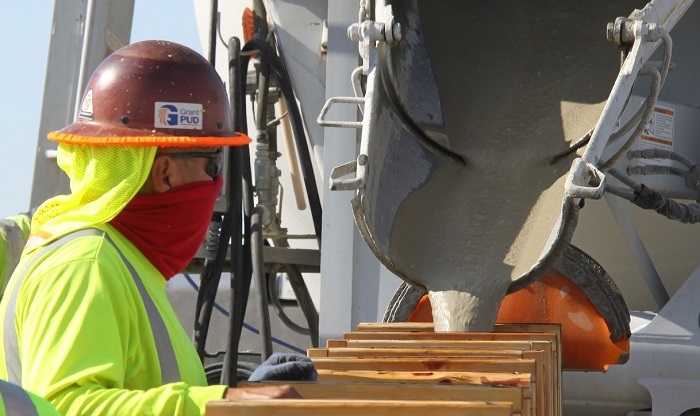 Eddie Fernandez, field superintendent, monitors the flow of a test batch of engineered grout before it is used to stabilize aging underground structures in the 200 West Area of the Hanford Site.
In July, workers removed obstructions from single-shell tanks as they prepared to retrieve radioactive and chemical waste from the site’s A Tank Farm. At the same time, offsite workers followed COVID-19 safety protocols while they built a full-scale mock-up to test operations to fill three aging underground disposal structures with engineered grout to stabilize the structures later this year.
Workers paved roads and parking lots at WTP, establishing the future operational area of the plant that will treat tank waste. Workers also began installing fencing, utilities, support structures, and other infrastructure for the nearby disposal facility that will receive canisters of vitrified low-activity tank waste. Vitrified waste is immobilized in glass.
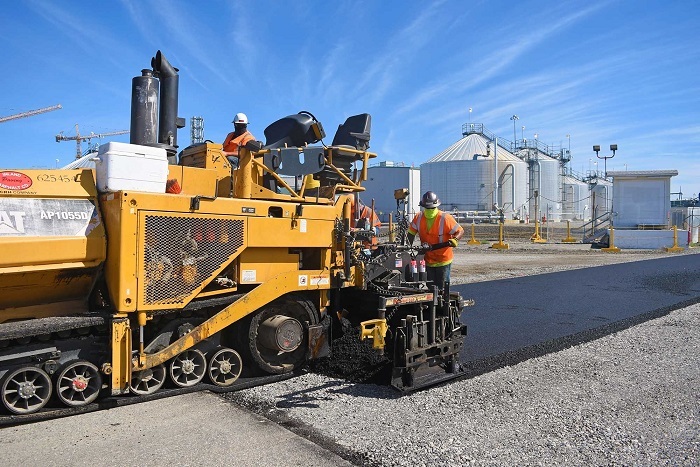 Workers paved roads and parking lots at the Waste Treatment and Immobilization Plant in July, establishing the future operational area of the plant that will treat tank waste.
In August, training kicked off for the final class of commissioning technicians who will prepare the massive treatment plant for 24/7 operations to vitrify millions of gallons of tank waste. Workers also finished successfully testing a pretreatment system that removes radioactive cesium and solids from tank waste to provide a feed of low-activity waste to the plant, and they started constructing a concrete pad next to Hanford tanks to hold the pretreatment system.
Energy Secretary Dan Brouillette viewed progress on that project and others that month.
“I’m pleased to see the tremendous work the team here at Hanford has done to protect its people, the communities, and the Columbia River,” Brouillette said. “We are now getting ready to move into the tank cleanup phase and address it in a safe, timely and cost-effective manner.”
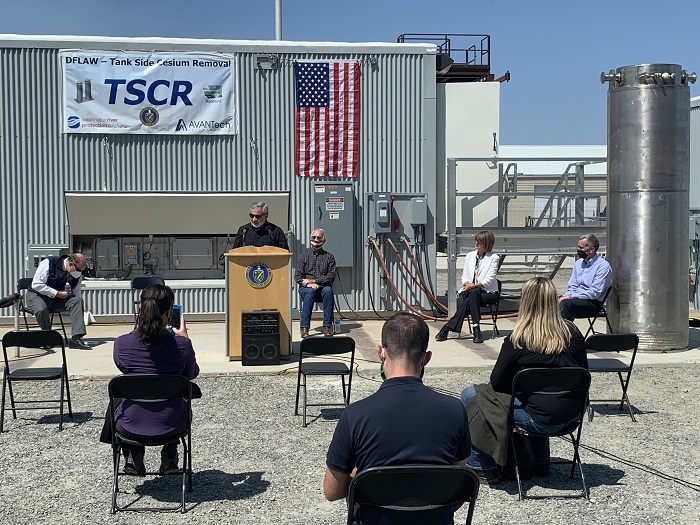 In August, Energy Secretary Dan Brouillette, at podium, toured AVANTech in Richland to see the Tank-Side Cesium Removal system that will be used at Hanford as part of the Direct-Feed Low-Activity Waste approach to tank waste treatment.
Chemists also made their final move into the Analytical Laboratory, culminating two years of developing training and procedures and verifying laboratory equipment performance while working at a nearby community college.
Workers broke ground on a storage area that will hold dry casks of nearly 2,000 capsules of cesium and strontium that are now stored in an underwater basin, while other workers continued building a mock-up to safely train and test equipment that will be used to move the highly radioactive capsules into the casks.
In the closing weeks of fiscal 2020, Hanford enhanced safety for workers and reduced the risk posed by chemical vapors by installing a new exhauster ventilation system above waste tanks in the A Farm to draw air from the tanks and send filtered air through 50-foot stacks, well above workers. And water treatment plant staff received a distinguished Silver Certificate of Achievement from the Washington State Department of Health for five consecutive years of high performance on removing particles from water to help protect workers at the site.
 Employees with Mission Support Alliance at the Hanford Site’s 283 West Water Treatment Plant — from left, Vinni Dragoo, Richard Herrera, Ed Lerma, Burke Neuman, and Bob Ward — display the Silver Certificate of Achievement presented by the Washington State Department of Health. The award recognized the superb quality of drinking water at Hanford and the team’s high performance for the past five years in removing even the smallest particles from water during treatment to ensure worker safety.
Brian Vance, manager of the EM Richland Operations Office and EM Office of River Protection, encouraged site workers in a recent message.
“Please remember the lessons we have learned over the past few months: maintain social distancing, wear face coverings, wash your hands often, and stay home if you are ill,” said Vance. “I remain confident that, working together, we will move forward towards a prosperous future, continuing to provide safe, efficient and effective cleanup of the Hanford Site.”
-Contributors: Hanford Site Communications Team
|



